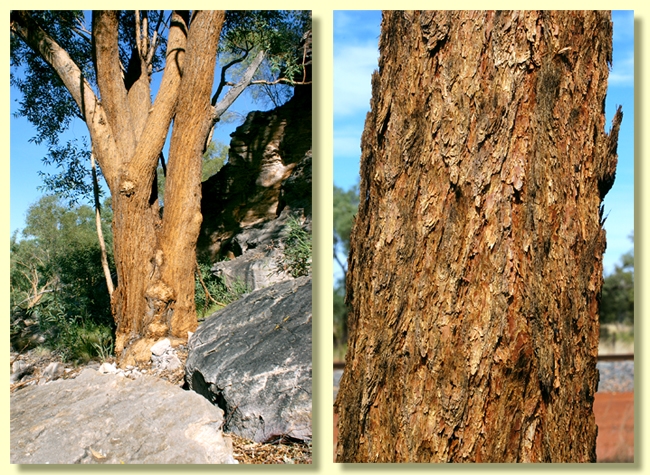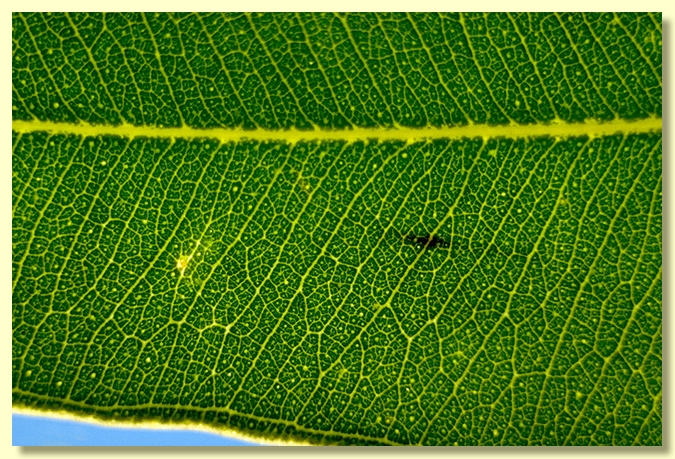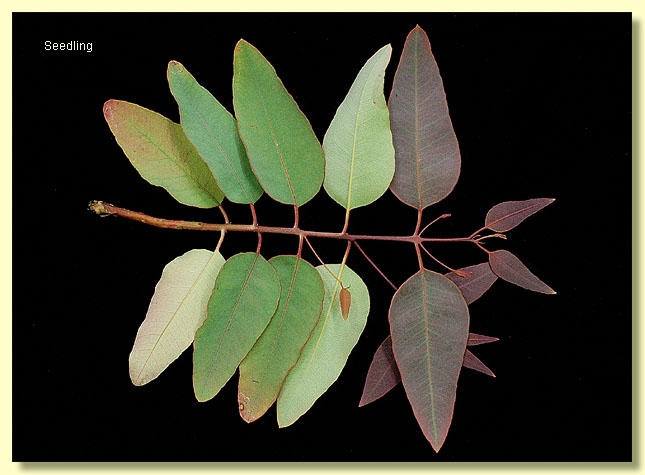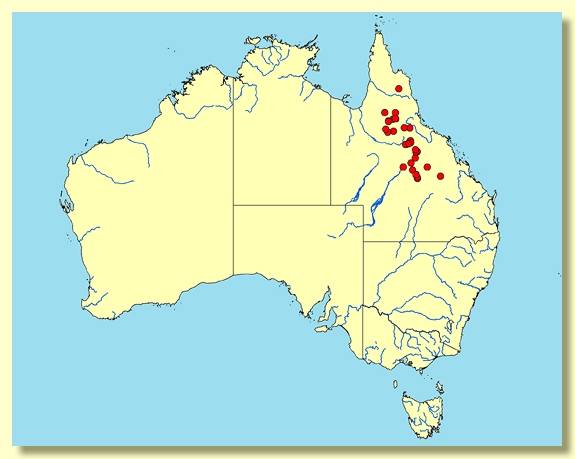Euclid - Online edition
Eucalyptus similis
Eucalyptus | Eudesmia | Reticulatae | Miniatae | Variabiles
Tree to 12 m tall. Forming a lignotuber.
Soft fibrous, or loosely flaky, papery, irregularly tessellated rough bark over most the trunk and branches, rough bark yellow to yellow-brown to red-brown, sometimes weathering to grey.
Juvenile growth (coppice or field seedlings to 50 cm): stems rounded in cross-section, glabrous; juvenile leaves sub-opposite or alternate, petiolate, ovate, 6–13 cm long, 3–7 cm wide, base rounded to tapering, apex rounded to acute, dull green.
Adult leaves alternate, petioles 1–2 cm long; blade lanceolate to broadly lanceolate or falcate, (7)8.5–18 cm long, 1–3.5 cm wide, base tapering to petiole, discolorous, dull green to slightly blue-green, side-veins acute or at a wider angle than 45° to the midrib, tertiary venation moderate to dense, intramarginal vein present and very close to the margin, oil glands mostly intersectional, rarely island.
Inflorescence axillary single, peduncles 1.4–2(2.3) cm long, rounded; buds 7 per umbel, pedicels 0.1–0.8 cm long. Mature buds cylindrical to pyriform to fusiform, 0.8–1.2 cm long, 0.4–0.5 cm wide, calyx fused to the corolla and evident as 4 small teeth at the apex of the bud, operculum conical to rounded, stamens irregularly to regularly flexed, anthers oblong, versatile, dorsifixed, dehiscing by longitudinal slits (non-confluent), style long, straight, sometimes hooked or bent beneath the apex of the bud, stigma tapered, locules usually 3(4), the ovules usually arranged in 4 distinct vertical rows on the placentae. Flowers white or cream.
Fruit pedicellate (pedicels 0.1–0.7 cm long), cylindrical to cup-shaped to barrel-shaped, 0.8–1.5 cm long, 0.6–1.3 cm wide, disc vertically descending, valves 3(4), exserted or near the rim.
Seeds dull grey, saucer-shaped or flattened-ovoid, (2)2.5–3.8 mm long, dorsal surface smooth, hilum ventral.
Cultivated seedlings (measured at node 10): cotyledons large, reniform, glossy green above, purple on underside; stems round in cross-section, with scattered stellate hairs on the lower stem sometimes to node 10 or 11; leaves always petiolate (to 1.6 cm), opposite for 7–11 nodes then alternate, ovate to broadly lanceolate, 7–11.7 cm long, 2.3–5.5 cm wide, base broadly tapering or rounded, lamina dull blue-green to mid-green and glabrous above, with a few scattered stellate hairs on the paler lower surface.
Flowering has been recorded in December (Brooker & Kleinig, 1994).
A small to medium-sized tree, occurring in a narrow north-south band of Central-eastern Queensland, from the Barcaldine–Jericho region, north to just west of Forsayth, with two disjunct populations on the Cape York Peninsula, one in the ranges near Laura and the other to the east of Strathburn Station. Eucalyptus similis is charactised by its rough, yellow to yellow-brown, papery or flaky bark on the trunk and large branches, the seven-budded axillary umbels and the discolorous adult leaves.
It belongs to the taxonomically complex subgenus Eudesmia and is included in the section Reticulatae, series Miniatae, subseries Variabiles characterised by having the calyx fused to the corolla and evident as four small teeth at the apex of the bud, hairy seedlings, adult leaf reticulation relatively dense, buds with a long style and anthers irregularly flexed. It is closest to E. lirata from the Kimberley region of Western Australia, the only other member of this subseries. The two species can be separated by their adult leaves, which are discolorous in E. similis and usually concolorous in E. lirata and by their peduncle length, which is 1.4–2.3 cm in E. similis and up to 0.8 cm long in E. lirata. E. similis may also be confused with E. baileyana, another Queensland rough-barked species belonging to the Eudesmia group. The two species can be easily separated on fruit shape and width. E. similis has smaller cylindrical to barrel-shaped fruit 0.6–1 cm wide, while E. baileyana has larger urceolate to globose fruit 1–1.7 cm wide. E. similis also has buds with a long style while E. baileyana has buds with a short style.
With its white flowers and smaller cylindrical fruit, E. similis should not be confused with other members of the Eudesmia group with the soft fibrous, flaky, papery bark, i.e. E. phoenicea, E. miniata, E. gigantangion, E. chartaboma and E. ceracea. All these species have bright orange flowers and much larger fruit than E. similis.
Eucalyptus similis: Latin similis, like, resembling, similar, according to Maiden’s protologue, referring to the similarities of this species with E. baileyana.


















